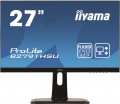Surface treatment
Modern monitors can use displays with both glossy and matte screen surfaces.
A matte surface is in some cases more preferable due to the fact that on a
glossy screen, when exposed to bright light, noticeable glare appears, sometimes interfering with viewing. On the other hand, glossy screens offer better picture quality, higher brightness, and richer colours.
Due to the development of technology,
monitors with a special anti-glare coating have appeared on the market, which, while maintaining all the advantages of a glossy screen, creates significantly less visible glare in bright ambient light.
Refresh rate (vert.)
The vertical refresh rate supported by the monitor.
Initially, the term "sweep frequency" was used in the characteristics of CRT monitors that work with an analogue signal. By tradition, it continues to be used for LCD matrices, however, for such screens, the refresh rate is actually the frame rate. See above for more on frame rate; here we note that in this case it is not the maximum frequency that is indicated, but the frequency range supported by the monitor — from the minimum to the maximum. This allows you to evaluate compatibility with certain video cards and operating modes: the frame rate of the video signal must match the frame rate of the monitor (or at least be a multiple of it), otherwise twitches and other unpleasant phenomena are possible.
It is worth noting that the monitor usually does not support any refresh rate from the range given in the specifications, but only certain standard values — for example, 50 Hz, 60 Hz and 75 Hz for the 50 – 75 Hz model.
Refresh rate (hor.)
The horizontal refresh rate of the image on the monitor screen.
This parameter was relevant for CRT monitors, in which the image was formed by an electron beam that "ran through" each individual line on the screen and illuminated the pixels. The horizontal refresh rate described the number of lines drawn per second. However, modern LCD matrices do not use a scan, but a full-frame image. Therefore, today this parameter is rarely given in monitors, and it describes the maximum horizontal frequency in an analogue video signal (for example, via the VGA interface), with which the screen can work normally.
Portrait pivot
The screen is 90° rotatable on a stand, from landscape (horizontal) to portrait (vertical). The vertical orientation of the screen (
portrait mode) can be useful, for example, when working with large documents made in portrait orientation.
Screen rotation
The presence of
a swivel stand in the design of the monitor allows you to change not only the angle of the screen (of course everyone has it), but also its rotation to the right and left. The angle of rotation depends on the model, but anyway, even a slight deviation allows you to quickly adjust the position of the monitor to your needs.
Height adjustment
The ability to move the monitor screen up and down relative to the base. This feature is very convenient for
adjusting the height of the screen — moving it on the mount is much easier than looking for a stand or resorting to other tricks.
Sound power
Rated power of the speakers installed in the monitor (see "Built-in speakers"). The higher the power, the louder the acoustics can sound, the easier it is to cover a vast space. However, in most cases, the user is directly in front of the monitor, and high volume is not required for normal hearing. So this parameter is critical mainly for plasma and LCD panels (see "Type").

